Abstract
The white meat value chain in Tanzania comprises both pigs (pork) and domestic fowl (chicken). The chain includes live animals, fresh meat, processed meat products and by-products from these species. Primary producers, traders in animals, in meat and in by-products, processors, butchers, other retail outlets and consumers participate in the chain. From supply and use of inputs, via production and processing to marketing and retailing the chain is confounded by a plethora of technical and institutional impediments. Fragmentation, lack of organization, absence of control (in spite of over-regulation) and almost total lack of coordination characterize the chain. Many participants have more than one role. Goods and services include land, labour, live animals, veterinary supplies, feed supplies, transport, energy, finance and (perhaps above all and what is most lacking) institutional support. Clearly defined and enunciated standards and a regulatory framework under law are needed. Many of these requirements continue to be weak, non-existent or are not applied in Tanzania.
Key words
smallholder producers, marketing, processing, pigs, pork, poultry, legislation
Introduction
A value chain covers the range of activities that is needed to channel a commodity through stages starting from the primary point of production to the final stage of consumption. An often-complex combination of physical change, inputs from various producer services, transfer of ownership and delivery is involved in the chain [1]. Commodity value chains are increasingly recognized as providing a solid framework for the analysis of the public and private sector stakeholders players within them as well as the overall performance of particular markets.
Pigs are of less importance in Tanzania’s livestock sector than ruminant animals whereas poultry individually provide small amounts of meat but nationally are extremely important at the household level. In the 50+ years between Independence in 1961 and the year 2016 the human population quadrupled. In the same period the pig population increased by a factor of 4.5 and chicken numbers by a factor of 5.2 [2]. White meat contributes only nine per cent to total meat consumption in the country [3]. The Tanzania white meat value chain, from supply and use of inputs, via production and processing to marketing and retailing is confounded by many technical and institutional impediments. The chain is fragmented, unorganized, uncontrolled (in spite of being over-regulated) and uncoordinated. Pig production is dominated by large numbers of small holder stock owners whereas poultry production is in part a small-scale family enterprise and in part a rapidly developing industrial business for both layers and broilers [4]. In addition, there is an unknown but undoubtedly enormous number of middlemen who operate across every link and a similarly unknown number of small processors and butchers who put products on the market for the consumer but who mainly lack the technical and financial ability to run it efficiently and profitably. The horizontal and vertical linkages of the value chain are generally weak and uncompetitive and in need of support to strengthen them as is the case for the red meat chain [5,6].
In Tanzania the “white meat” value chain includes live animals, meat, processed meat products and by-products from pigs and poultry. These are mainly sold locally although there is a small and expanding export market principally aimed at neighbouring countries. There is rising demand for pig and poultry meat both in the raw state and as processed items driven by an increasing population and changing consumer tastes. Primary processed meat and meat products are derived after animals are slaughtered and include carcasses and offal’s (liver, lungs, heart and kidneys) and small quantities of other by-products (blood, glands, intestines, stomachs and gut contents)
Participants in the value chain include primary producers, traders in animals, in meat and in by-products, processors, butchers, other retail outlets and consumers. Most actors are not specialized, and their functions relate to various segments of the chain. Many primary producers, for example, engage in trading of animals and some upstream actors, such as butchers, trade in animals and meat and undertake primary processing for production of higher value products. There is a very small market segment in quality products in the tourism sector and to serve a few high wealth Tanzanians and the few expatriates living in the country (Figure 1).

Figure 1. A specialist one-man butchery in Morogoro supplying bespoke products to a niche market and a retail outlet of an integrated poultry enterprise (Photos: Author).
Material and method
This study derives from work in Tanzania in 2012 and 2013. A thorough review of the literature was first undertaken. Field visits were made to all the areas in the country where livestock are reared, except the western provinces. Discussions were held with individual participants operating throughout the chain, with focus groups and with technical and administrative personnel in both public and private sectors. Analysis and report production were then carried out according to standard methods [7,8].
The value chain maps
The value chain maps (Figure 2-4) show that the whole is suspended from the consumer. If this link to the rest of the chain were to be broken the whole would be susceptible to collapse. This situation is more or less true for all other links in the chain. Each link takes the product from its immediate predecessor and “processes” it to an output that is used by the next link. Nominally, the value of product increases at each stage until it reaches the consumer. A succinct list of most of the participants in the chain shows its complexity (Table 1) but pivotal roles are played by the middle links through which all products must pass. Many participants occupy more than one role (Table 2). Some small-scale livestock producers but especially those of slightly larger scale also act as processors and retailers. Further up the chain some processors are also wholesalers and retailers and operate in both the domestic and export markets. Primary producers sell pigs and poultry informally direct to a consumer, directly through a market, to a trader or to a processor or may use a combination of all several outlets. A trader may sell to another trader, directly to a wholesale or retail butcher or to a processor or, again, may broaden his option by using a combination of these channels. Processors, especially the smaller enterprises, may buy animals directly from farmers or from traders and sell the products to wholesalers or retailers (Figure 5).
Table 1. Simple listing of supply and service participants in the White Meat Value Chain.
Core participants |
Service suppliers |
Producers: traditional primary producers (pigs and poultry), semicommercial and commercial producers (pigs), integrated enterprises (hatcheries > day-old-chicks > growers > slaughterers > processors) (poultry), outgrowers (broilers)
Traders and agents (pigs and poultry)
Slaughterers (pigs and poultry)
Wholesalers (pigs and poultry)
Butchers/point of sale (rural, urban, quality butcheries and supermarkets) (pigs and poultry)
Meat product retailers (street vendors, shops, supermarkets) (pigs and poultry)
Cafés and retailers (‘kitimoto’ for pigs, poultry)
Importers (live pigs/birds, eggs, meat and meat products) |
Research
Training and Education Institutions
Extension service
Inputs (Veterinary, Feed)
Transport
Financial services
Slaughterers
Meat inspectors
Associations (producer, trader, processor)
Tanzania Meat Board |
Table 2. Participants and functions in the Southern Highlands White Meat Value Chain.
Participant |
Functions |
Research |
Pig and poultry research is very limited. Uyole Agricultural Research Institute Mbeya has responsibilities in training and extension. The Regional Veterinary Investigation Centres are the reference laboratories for disease identification. |
Feed manufacturers and suppliers |
Several large scale and numerous small and medium scale feed compounders operate in Dar es Salaam and in some main towns. Numerous (as many as 500 with trading licences) small private retailers sell small quantities of feed and feed additives and supplements. Main products are Chick Starter (and a more expensive version containing a coccidiostat), Layers, Broiler Starter, Broiler Growers and Broiler Finisher: in 2013 all is in the form of mash although some firms have or will shortly have pelleting capacity. There is no regular production of pig compound feeds. Many small producers buy ingredients and mix their own concentrate feed. |
Other input suppliers |
The Ministry of Livestock and Fisheries Development and the municipalities provide limited extension and animal health services. Financial services are extremely limited and available only to a favoured few. |
Producers |
Most stock are kept by traditional smallholders who keep mixed breed pigs and indigenous domestic fowl types. “Out growers” purchase day-old broiler chick direct from integrated poultry enterprises or through their agents. Several Christian mission stations keep better quality pigs that serve as a reservoir for distribution to smallholders. |
Traders |
Primary buyers and secondary buyer-agents operate throughout the country. Trading often takes place at the point of production. Some long-distance trade towards the Dar es Salaam market by road transport is undertaken but most is more local. |
Slaughterers and processors |
Most slaughtering of pigs is “informal” and done at, or very close to, the point of production. Pigs are sometimes slaughtered at rural slabs that are often not registered and not inspected. There are many registered pig slaughter slabs in Dar es Salaam and others in the main towns that are subject to control and meat inspection (although coverage is not 100 per cent). There is one specialist processor of pig meat into value added products in Morogoro. Poultry are usually slaughtered at the point of consumption. Kisutu market in central Dar es Salaam is the principal recognized controlled slaughter point for poultry. Three (one not operating) integrated poultry enterprises have slaughtering, dressing and processing lines. |
Retailers |
Retailing of pig meat is usually done by recognized but informal businesses. There are specialist eating establishments for pig meat (‘kitimoto’). Processed products (sausages and bacon) imported from Kenya or from very small local processors are sold in many non-Muslim supermarkets. Live poultry are sold at roadside stations and in rural, suburban and urban markets. Hotels, restaurants and supermarkets buy poultry at some larger markets. Whole dressed birds and speciality cuts are available at most supermarkets and some specialized retail shops. |
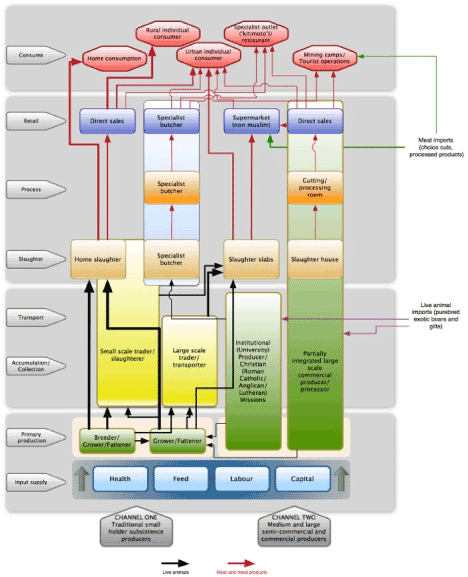
Figure 2. The Red Meat Value Chain in Tanzania.
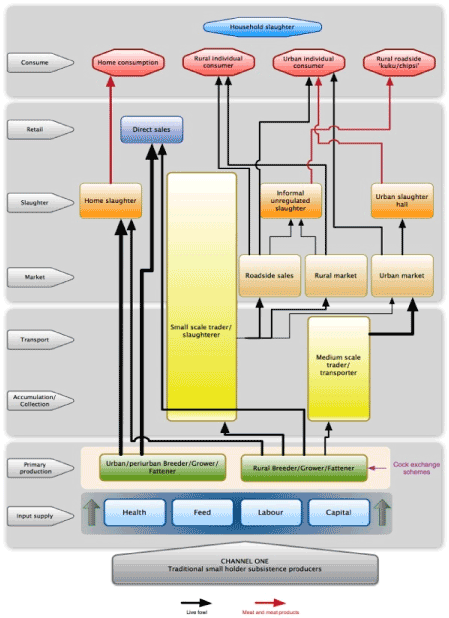
Figure 3. Some examples of red meat pathways from point of production to final consumption.
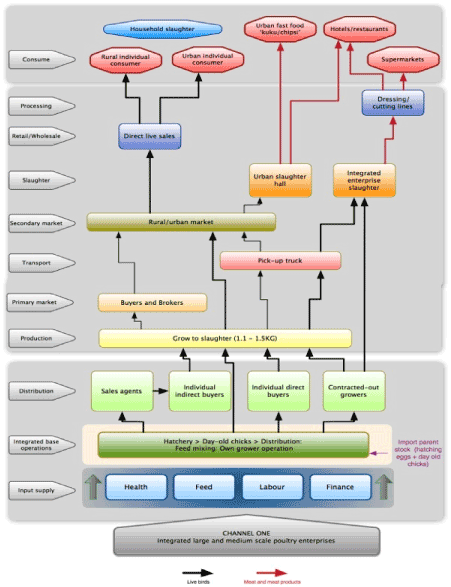
Figure 4. Indigenous livestock of Tanzania: Tanganyika Shorthorn Zebu cows; Masai-type sheep; Small East African goats.
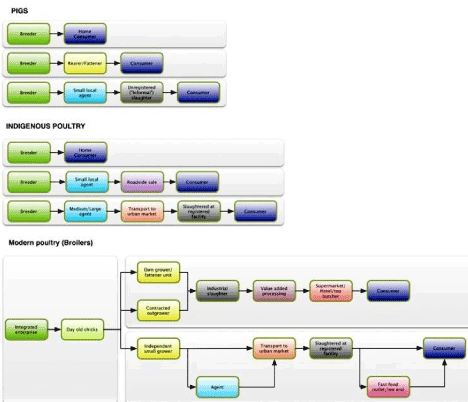
Figure 5. Some examples of pathways followed from point of production to final consumption for pigs, scavenger (indigenous) fowl and small-scale broiler production.
Every link in the chain relies on goods and services in order to fulfil its role(s). At the various stages, goods and services include land, labour, live animals, veterinary supplies, feed supplies, transport, energy and finance. Also required are clearly defined and enunciated standards and a regulatory framework under – and applied by – law. Many of these requirements continue to be weak or non-existent in Tanzania.
Technology generation
Technology in livestock production includes inputs such as feed or veterinary medicine at the producer level, machinery use in slaughtering and processing and proper and hygienic presentation of products at the retail level. Technology has a key role in improving competitiveness and especially vis-à-vis near neighbours operating in and competing for the same environment.
White meat production is mainly based on traditional systems that use very little modern technology. Most pigs originated as imported European breeds, but these have become “indigenized” and degraded in part because of in-breeding. Domestic fowl are also indigenous types that lay small discrete clutches not more than three times per year [9]. The “modern” sector is represented, for pigs, by a few herds at Christian mission stations and a few private farms that are mostly owned by European settlers or long-term expatriates and in which controlled breeding, feeding of balanced rations and provision of regular veterinary care is practised. The modern poultry sector comprises mainly small to medium scale producers with 200 to 2000 birds that are obtained from the main integrated poultry enterprises that produce day-old chicks: in this system housing, balanced feed and veterinary care is provided. In the traditional system pigs and poultry derive feed almost in its entirety from scavenging. Pigs that are housed usually receive some maize bran as a basal ration but are mainly raised on cut and carried green feed. Most pigs and poultry receive little in the way of animal health treatments such as protection from ticks (and the diseases they carry) or control of internal helminth parasites. African Swine Fever is endemic in pigs [3] and they are beset by many other diseases some of which are also zoonoses [10-12]. Poultry are also affected by many health hazards [13] although an increasing number of poultry in the traditional system are being vaccinated against Newcastle Disease by a thermostable vaccine produced by the Tanzania Veterinary Laboratory Agency (TVLA) in Dar es Salaam [14]. As a consequence, if the animal does not succumb to its miserable life style (death rates are very high in piglets and very young chickens) overall growth rates are low. Thus, output is greatly reduced due to a combination of under- and mal-nutrition and poor health status [15].
Several technological interventions are available but for the most part they are not used by producers and probably not even communicated to them by technical staff. Some are, indeed, somewhat sophisticated or too expensive for use at the present state of development of the regional herds and flocks. Low adoption is caused by poor extension services, difficulties in gaining access to the technologies (cost/location) and the low level of knowledge among most livestock keepers.
Uyole Livestock Research Centre is an example of a regional facility and has the mandate for applied research for much of the Southern Highlands. It is committed to researching and facilitating the adoption of appropriate technologies in the region. Its impact is limited, however, by low staffing levels and limited budgets. Similarly, the official extension services suffer from the same problems.
Adoption of known improved but not over ambitious management and technological practices can, however, bring about spectacular increases in the output and quality of livestock products. Amongst such are:
• strict implementation of parasite control regimes recommended by the veterinary authority;
• vaccination against epidemic and endemic diseases, both “trade” and “production”;
• regular (daily at least) access to water; and
• use of mineral and vitamin supplements to target groups.
Failure to overcome the lack of use of available, effective, cheap and simple technology will inevitably result in even further loss of competitiveness as the peers of Tanzania’s livestock producers and processors in neighbouring countries, especially Kenya, are making widespread use of it.
Input supply and demand
The most important inputs for white meat production are perceived to be:
• animal health products including drugs and vaccines;
• nutritional supplements (concentrates, mineral and vitamins);
• fixed and mobile equipment and tools;
• breeding animals (mostly males but also females for pigs); and
• credit.
Limited access to inputs including credit, the high incidence of livestock disease and poor dissemination and uptake of knowledge on improved management are recognized constraints to development of the smallholder livestock sector. According to the National Panel Survey (NPS) of 2008-2009 [16] the whole farming sector makes extremely limited use of modern inputs. Only 6 per cent of rural livestock keepers use hired labour for livestock activities and only 20 per cent buy fodder. The proportion buying fodder ranges from 13 per cent for the poorest households to 37 per cent for the more affluent rural households. This could reflect greater purchasing power but also differences in the household livestock mix or rearing system.
Access to extension services is apparently not quite so limited as access to credit but is nevertheless not very widespread [16]. Just over one quarter of rural livestock producers made use of extension services and received advice on production practices or disease prevention and control. Access seems to be positively related to wealth but is also related to the number of animals kept by a household. This could be because households with more livestock have greater dependence on these for their livelihoods.
Public veterinary services are supposedly widely available but there is clearly inadequate provision. Only 29 per cent of households used any form of vaccination and use of other veterinary inputs is limited [16]. Actions to livestock disease tend to be reactive rather than proactive. Access to animal health services and products is better in and near towns where private suppliers are rather common and supply a wide range of local and international drugs and health supplements and nutritionally balanced feeds (Figure 6).
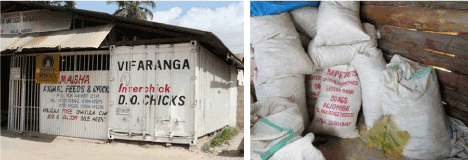
Figure 6. Sales agent for chicks and feed in Iringa and compound poultry feed manufactured in Njombe (Photos: Author).
There is considerable use of purchased concentrate feeds in the broiler section of the white meat chain. Several maize and wheat flour millers produce animal feeds and there is a number of specialized companies in Dar es Salaam and its environs and many more in the larger towns. Millers who produce feed are, in effect, using a by-product – wheat or maize bran – of their operations to produce a high value product whereas specialized firms have to obtain their ingredients from a variety of sources: maize and wheat bran from internal resources, sunflower cake also from the local oil milling industry (limited amounts of cotton seed cake are also used) and fish meal (made from pounded ‘dagaa’) mainly from Lake Victoria. Soya bean meal is increasingly being used as a protein replacement for fish meal, but the local product is not preferred as better (and more consistent) quality product that is also de-fatted can be obtained more cheaply from India. The Tanzania Animal Feed Manufacturing Association (TAFMA) represents the animal feed manufacturers. Compound feeds are more widely available in the populated areas than in the remoter parts of the country where most pigs and poultry are found. Many medium scale producers resort to mixing their own compounds from individual commodities, especially in the rural areas and especially for pigs. This imbalance in location and availability of inputs – both health and nutritional – is a fundamental problem for the chain.
Import and distribution of most veterinary drugs and vaccines have been privatized but there are exceptions for some specified biologicals. The thermostable I-2 Newcastle Disease vaccine, for example, is produced only by the TVLA. Government exempts all specialized livestock-related inputs from import and sales taxes. These measures are intended to reduce the costs of production of livestock. The few distribution centres in rural areas, especially in the remoter pastoral areas, force producers to travel long distances to towns to purchase inputs. Producers can obtain some inputs at rural markets and other informal distribution points but the risks here are that the products are counterfeit or have been diluted and there is little quality control. Procurement of inputs from informal channels combined with administration of drugs by untrained livestock keepers can make the cure worse than the disease.
Maize bran is the main by-product of the milling industry and a potential major feed supplement for white meat production but much of it is wasted or used as a fertilizer/soil improver. Other crop by-products include oilseed cakes and rice hulls. Mineral and vitamin supplements and pre-mixes are mostly imported.
The National Microfinance Bank (NMB) and the Cooperative Rural Development Bank (CRDB) are the main and largest providers of credit to agriculture in general in Tanzania. NMB has a range of products including loans for farmer groups and also Small and Medium Enterprises (SME) loans applicable to processors. Collateral requirements are strict, and livestock have not been accepted as collateral until recently. Interest rates are based on Treasury Bills plus 1 or 2 per cent and range from 19 per cent for SME to 24 per cent for micro enterprises. Both banks provide funds to Savings and Credit Cooperative Societies (SACCOS) and Microfinance Institutions (MFI). Several other banks, including the Tanzania Postal Bank (TPB), National Bank of Commerce (NBC) and Exim Bank (Tanzania) (EBT) operate in the country and could be sources of credit for livestock in the future. Government is in the process of establishing an Agricultural Bank as proposed in the “Kilimo Kwanza” (Agriculture First) initiative and has made a start with the Agriculture Window Unit in the Tanzania Investment Bank.
An abundance of reports, workshops, projects and programmes have masqueraded as – or been proxy for – development of the white meat industries. More than 200 years ago Adam Smith said that “consumption is the sole end and purpose of all production” [17]. This adage holds true to this day. The mass of Tanzania’s people still does not have enough to eat and even were there to be enough they would not be able to afford to buy it [18]. Failure to overcome the lack of use of available, effective, cheap and simple technology will inevitably result in even further loss of competitiveness as the peers of Tanzania’s livestock producers and processors in neighbouring countries, especially Kenya, are making widespread use of it [19].
Combinations of the three main types of livestock technology interventions – feed, health and genetics – and an enabling policy environment are needed if higher animal productivity and more substantial household incomes are to be achieved and the national development objectives are to be met. Appropriate combinations, dependent on biophysical, agro-ecological and market conditions, include:
• feed and health interventions and measures to reduce young and adult stock mortality;
• investing in promotional activities to change tastes and preferences from red meat to white;
• give priority to investments in genetic improvement of chickens by focussing on crossbreds and exotic pure breeds for both family and commercial enterprises;
• placing more emphasis on policies that could create a conducive environment for investment in commercial meat production and processing; and,
• promoting land allocation and ownership policies that facilitate increased feed availability for meat (and egg) production.
Acknowledgement
I thank Michael Winklmaier, Chief Technical Adviser of the Southern Highlands Food Systems, for his encouragement and support during the course of the original study. Peter Jimbuku, driver extraordinary and general factotum, is thanked for his assistance during the course of field work. Numerous participants in all the links of the chain were extremely helpful in providing information.
Funding details
This paper is an extract f
2021 Copyright OAT. All rights reserv
rom a white meat study which was one of a series of commodity studies carried out by the Tanzania Southern Highlands Food Systems Programme. These studies were financed by the Food and Agriculture Organization of the United Nations.
Competing interest
The author declares no conflict of interest.
References
- Porter ME (1985) Competitive Advantage: Creating and Sustaining Superior Performance. New York: Simon and Schuster.
- FAOStat (2016) Rome: Food and Agriculture Organization.
- Michael S, Stapleton J, Shapiro B (2017) Tanzania livestock master plan – key findings. Nairobi: International Livestock Research Institute/Dar es Salaam: Ministry of Livestock and Fisheries Development.
- URT (2012) National Sample Census of Agriculture 2007/2008 Small Holder Agriculture Volume III: Livestock Sector - National Report. Dar es Salaam: Prime Minister’s Office.
- Hartwich F (2011) The Tanzanian Red Meat/Leather Value Chain: A Diagnostic. Dar es Salaam: United Nations Industrial Development Organization.
- Wilson RT (2018) The Red Meat Value Chain in Tanzania. Anim Husb Dairy Vet Sci 2: 1-5.
- Schmitz H (2005) Value Chain Analysis for Policy-Makers and Practitioners. Geneva: International Labour Organization.
- FAO (2009) Red Meat Agribusiness Handbook. Rome: Food and Agriculture Organization.
- Mwalusanya NA, Katule AM, Mutayoba SK, Mtambo MM, Olsen JE, et al. (2002) Productivity of local chickens under village management conditions. Trop Anim Health Prod 34: 405-416. [Crossref]
- Boa ME, Kassuku AA, Willingham AL, Keyyu JD, Phiri IK, et al. (2002) Distribution and density of cysticerci of Taenia solium by muscle groups and organs in naturally infected local finished pigs in Tanzania. Vet Parasitol 106: 155-164. [Crossref]
- Nonga HE, Karimuribo ED (2009) A retrospective survey of hydatidosis in livestock in Arusha, Tanzania, based on abattoir data during 2005-2007. Trop Anim Health Prod 41: 1253-1257. [Crossref]
- Ngowi HA, Kassuku AA, Maeda GE, Boa ME, Willingham AL (2004) A slaughter slab survey for extra-intestinal porcine helminth infections in northern Tanzania. Trop Anim Health Prod 36: 335-340. [Crossref]
- Muhairwa AP, Mtambo MM, Christensen JP, Bisgaard M (2001) Occurrence of Pasteurella multocida and related species in village free ranging chickens and their animal contacts in Tanzania. Vet Microbiol 78: 139-153. [Crossref]
- Wambura PN, Kapaga AM, Hyera JMK (2000) Experimental trials with a thermostable Newcastle disease virus (strain I-2) in commercial and village chickens in Tanzania. Prev Vet Med 43: 75-83. [Crossref]
- MLFD (2010) Livestock Sector Development Strategy. Dar es Salaam: Ministry of Livestock and Fisheries Development.
- NBS (2010) Tanzania National Panel Survey Report Round 1, 2008-2009. Dar es Salaam: National Bureau of Statistics.
- Smith A (1776) An Inquiry into the Nature and Causes of the Wealth of Nations (Book IV, Chapter 8, P. 49). London: Methuen & Co.
- Mnenwa R, Maliti E (2010) A Comparative Analysis of Poverty Incidence in Farming Systems of Tanzania Special Paper 10/4. Dar es Salaam: Research on Poverty Alleviation.
- MMA/CDP-EA (2008) Red meat for local and export markets: sub sector analysis Tanzania. Dar es Salaam: Match Maker Associates Limited (MMA) & Consultants for Development Programs (CDP-EA).






